Princess Beatrice’s Wedding Was Surprisingly Similar to Queen Elizabeth's
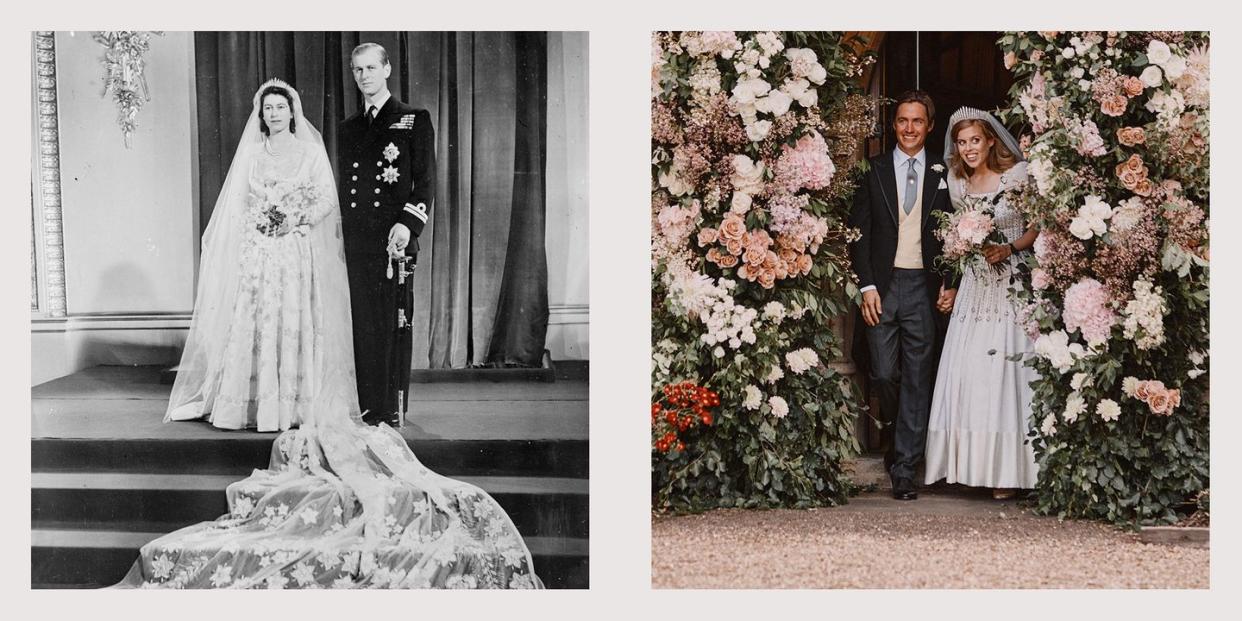
On the surface, Princess Beatrice’s wedding to Edoardo Mapelli Mozzi was vastly different than Queen Elizabeth’s 1947 marriage to Prince Philip. With decades between the two weddings, we see how a modern royal like Beatrice has deviated from certain traditions, while honoring her family by embracing others.
When the novel coronavirus hit the UK, Buckingham Palace released a statement that Beatrice and Edoardo’s wedding plans were “under review,” prompting royal followers to question what an alternative celebration could look like.
Just last week, the couple tied the knot with a decidedly intimate ceremony—and those paying close attention quickly connected the dots between the Princess's and Queen Elizabeth’s respective ceremonies. From the dress to the venue, we can see how Beatrice honored her grandmother, while taking inspiration from the British monarch’s own nuptials. Read on to see how Princess Beatrice’s wedding compared to that of Queen Elizabeth.
Difficult Circumstances
For both Queen Elizabeth and Princess Beatrice, difficult circumstances shaped how the royal brides prepared for—and celebrated—their weddings. In the time leading up to then-Princess Elizabeth’s ceremony, which took place in the aftermath of World War II, money was still scarce, and everything from food to clothes was rationed. Even the future Queen was not exempt from these efforts to reduce the consumption of goods. After saving up clothing coupons (how the British paid for their clothes during the postwar shortages) to buy her wedding dress, Princess Elizabeth was awarded 200 extra coupons by the government, and ended up in her dream ensemble for the big day.
While Princess Beatrice’s wedding was not limited by financial restraints, the dangers of COVID-19 loomed overhead for some time during her engagement to Edoardo, and ultimately lead the royal to change her wedding plans entirely. Princess Beatrice was set to marry Mozzi in London on May 29, 2020, with a reception in the Buckingham Palace gardens, but on July 17, she and her family surprised the public with a small, intimate wedding in Windsor.
Photos released by Buckingham Palace depict the bride as cheerful and radiant, though we must wonder what the day was like behind the scenes, not only because of the pandemic, but also the scandal surrounding her father, Prince Andrew, and his association with Ghislaine Maxwell and Jeffrey Epstein. While Andrew attended the wedding and walked his daughter down the aisle, he has been excluded from all official photos released to the press this far.
Two Very Different Ceremonies
As the future monarch, Princess Elizabeth was to have all the trappings of a spectacular royal affair—and that she did. On November 20, 1947, in a ceremony that was broadcast on the radio to millions of listeners, Elizabeth tied the knot with Prince Philip at Westminster. She and her husband were joined by 2,500 guests, including seven queens and six kings from a range of countries. Given the scale of the royal wedding, Queen Elizabeth (appropriately) had eight bridesmaids in her wedding party, including her sister, Princess Margaret, and her cousin, Princess Alexandra.

Unlike the Queen, Princess Beatrice tied the knot with a small ceremony held at the Royal Chapel of All Saints at Royal Lodge, on the grounds of Windsor Great Park. She was joined by her grandparents, Queen Elizabeth and the Duke of Edinburgh, her mother, Sarah Ferguson, father, Prince Andrew, and sister, Princess Eugenie. Edoardo’s parents and son, Wolfie—who served as the pageboy—were also in attendance. Despite its smaller scale, the celebration still had a grande aesthetic, with plenty of nods to the royal tradition. The wedding’s “secret garden” theme was executed beautifully, especially with a backdrop of lush gardens and overflowing floral arrangements.
Royal Wedding Dresses: "Something New" and "Something Borrowed"
In 1947, then 21-year-old Princess Elizabeth tapped Norman Hartnell (the designer who also made Beatrice’s vintage gown) to craft a stunning custom wedding gown from ivory silk. The gown, which featured a 13-foot-long train, detailed with cascading star patterns, reportedly took 350 women seven weeks to make, and it was said to have been inspired by a Botticelli painting.

Princess Beatrice chose a vintage Norman Hartnell-designed gown for her ceremony instead of opting for a new, custom garment like many other royal brides have. (Kate Middleton and Meghan Markle, for example, worked with couturiers for their own weddings.) Beatrice’s gown—“made from Peau De Soie taffeta in shades of ivory, trimmed with ivory Duchess satin, with organza sleeves,” according to a statement from Buckingham Palace—was remodeled and fit to perfection by Angela Kelly and Stewart Parvin, two trusted dressmakers who've worked closely with Queen Elizabeth in the past. Royal watchers were quick to point out that Princess Beatrice’s dress was not just any vintage gown, but one that had been worn by the Queen several times in the preceding years (most notably at the 1967 opening of parliament).
Two Norman Hartnell Designs
The connective tissue between the Princess's and Queen’s gowns is the designer, Norman Hartnell, who was at one point the Windsors' go-to dressmaker. Hartnell got his start designing for the royal family with Princess Alice’s wedding, where he was tapped to design both the wedding dress and those of the bridesmaids—including then-princesses Elizabeth and Margaret. The Queen Mother, having noticed how beautiful her daughters looked in the bridesmaid gowns, became delighted by Hartnell’s work.
He soon became a favorite of their family. The fact that Hartnell’s name was behind both Princess Beatrice and Queen Elizabeth’s dresses isn’t where the similarities end, though. Many have compared the intricate bodice of Beatrice’s gown—encrusted with diamanté, with a geometric checkered design—to the Queen’s gown, which was decorated similarly with 10,000 seed pearls.
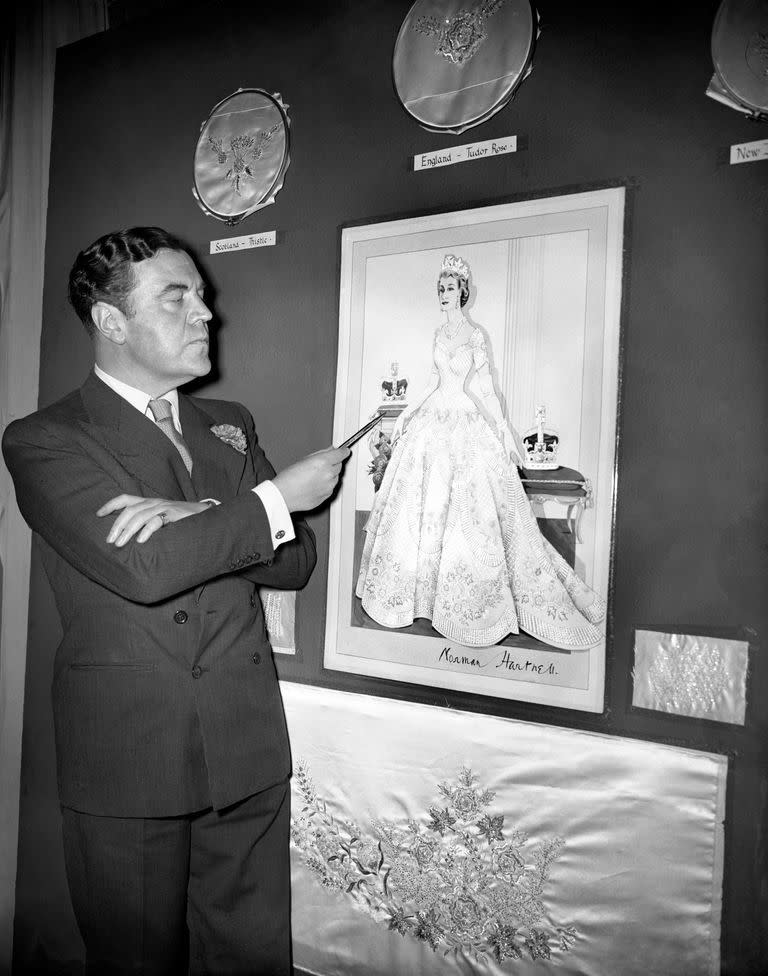
How Princess Beatrice's Ring Broke Royal Tradition
When Edoardo proposed to Beatrice in September 2019, he chose a custom-designed engagement ring by British jeweler Shaun Leane. For the wedding, Edoardo tapped Leane yet again to craft Beatrice’s wedding band, which attracted attention from the public for breaking from royal tradition. Royal wedding rings—including Princess Eugenie’s, Meghan Markle’s, Kate Middleton’s and the Queen's—are typically made from Welsh gold, though Edoardo opted for a platinum-and-diamond band that perfectly complemented her stately engagement ring. Leane described the style as a “fusion of Victorian and Art Deco designs.”
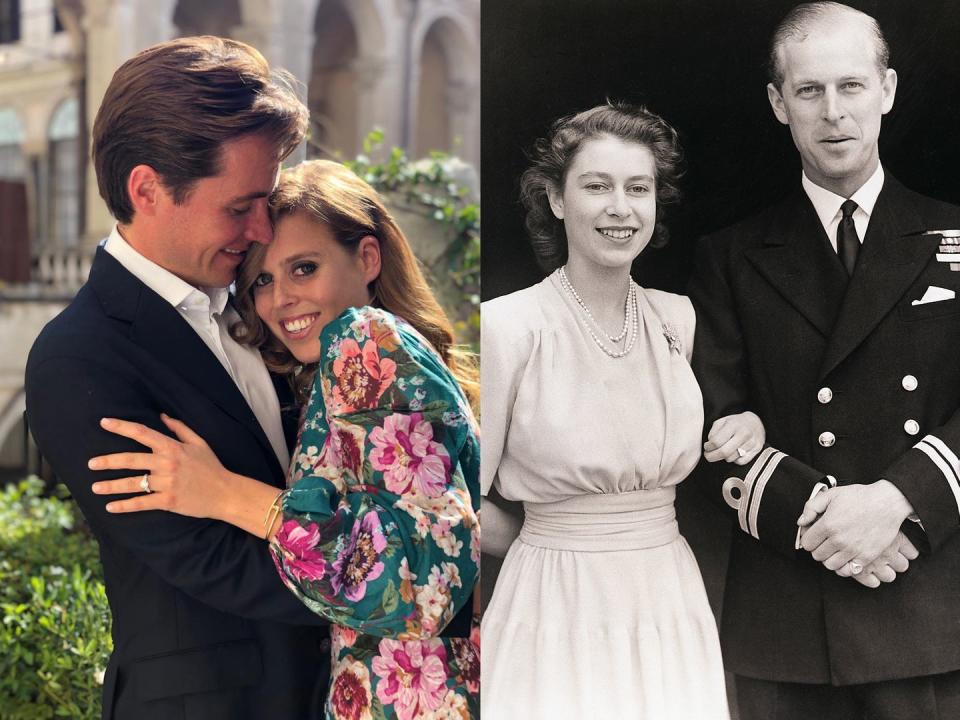
While the Queen's wedding band is indeed made of Welsh gold, her engagement ring has a rich royal history. Prince Philip's mother, Princess Alice, gave her son her wedding tiara, with the idea that he would re-fashion the headpiece into a sparkling engagement ring for his future bride. The resulting piece, a three-carat round diamond engagement ring, is one the Queen rarely takes off, and for good reason: Philip worked with London jeweler Philip Antrobus Ltd. and designed it himself. The diamonds date back to the end of the Romanov dynasty, as the original tiara was given to Philip’s mother by Tsar Nicholas II and Tsarina Alexandra of Russia.
The Queen Mary Fringe Tiara
When then-Princess Elizabeth married Prince Philip in 1947, she topped her bridal look with the Queen Mary Fringe tiara. The royal paired the classic piece with a long veil that cascaded onto the train of her dress. The tiara originated as a necklace, which Queen Victoria gave to Mary on her wedding day in 1893. (It was then that it was re-fashioned into a tiara). The tiara’s deep-rooted royal history is what makes the piece so significant, and an honor to anyone who wears it. So when Beatrice was seen in the same royal topper on her wedding day last week, it was more than just a sartorial statement—it signaled solidarity and support in even the most trying times. The Queen was not simply lending a piece of jewelry, she was sending a message of unity both to the newlyweds—and the world.
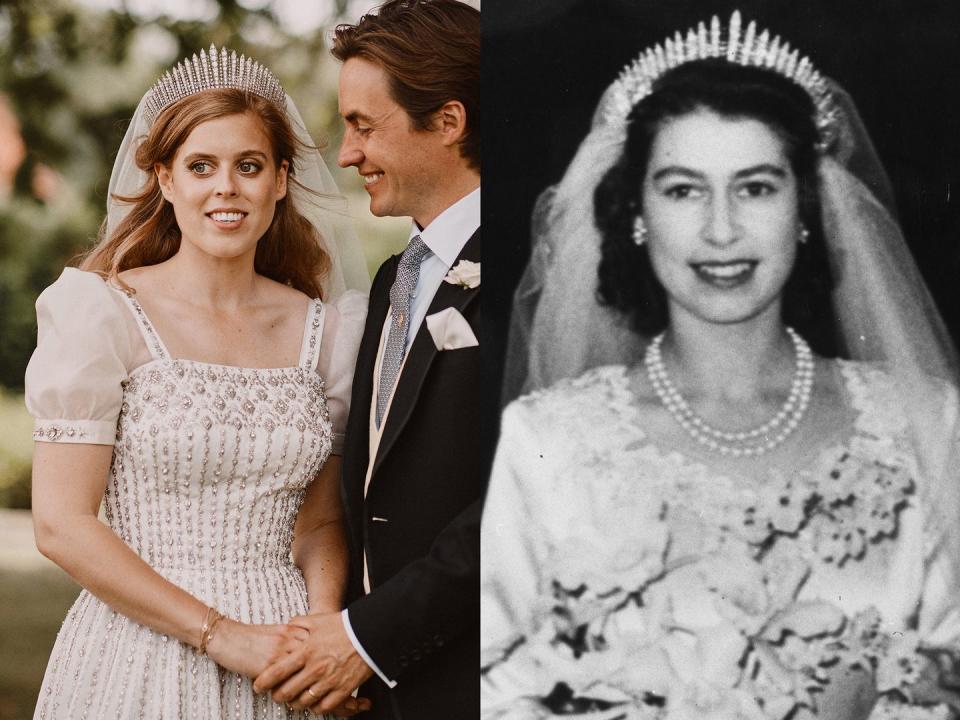
The One Flower the Two Royal Brides Had in Common
With Princess Beatrice’s “secret garden” theme, floral arrangements were essential in conjuring a whimsical vibe for the quaint wedding. Her bouquet was designed by Patrice Van Helden, co-owner of RVH Floral Design, and included trailing jasmine, pale pink and cream sweet peas, royal porcelain ivory spray roses, pink o’hara garden roses, pink wax flower, and baby pink astilbe. The assortment of flowers matched the floral archway that was assembled in front of the chapel door. Sprigs of myrtle (known to be an emblem of matrimony) were also weaved into the Princess’s arrangement, a royal tradition that dates back to 1858.
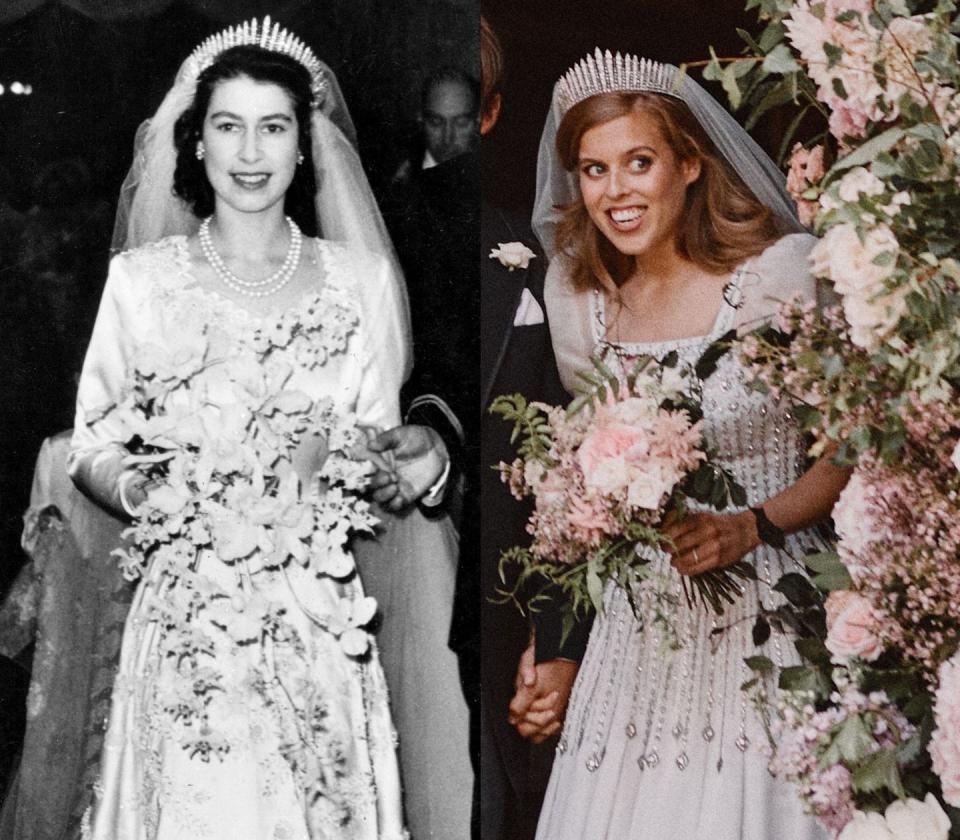
Like many other royal brides, Queen Elizabeth chose an all-white bouquet for her ceremony, made up of white orchids and a sprig of myrtle. Both the Queen and Princess Beatrice followed another tradition with their bouquet: sending it to the tomb of the Unknown Warrior in Westminster Abbey.
You Might Also Like


